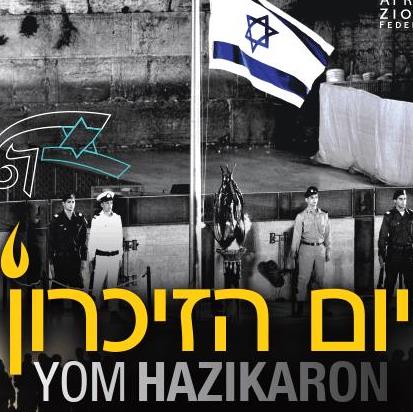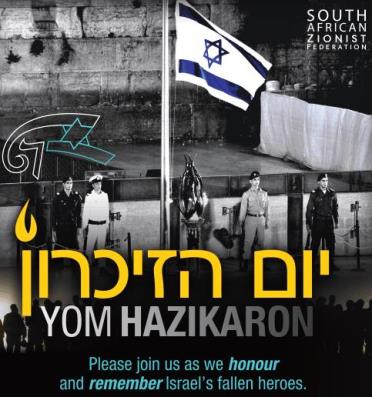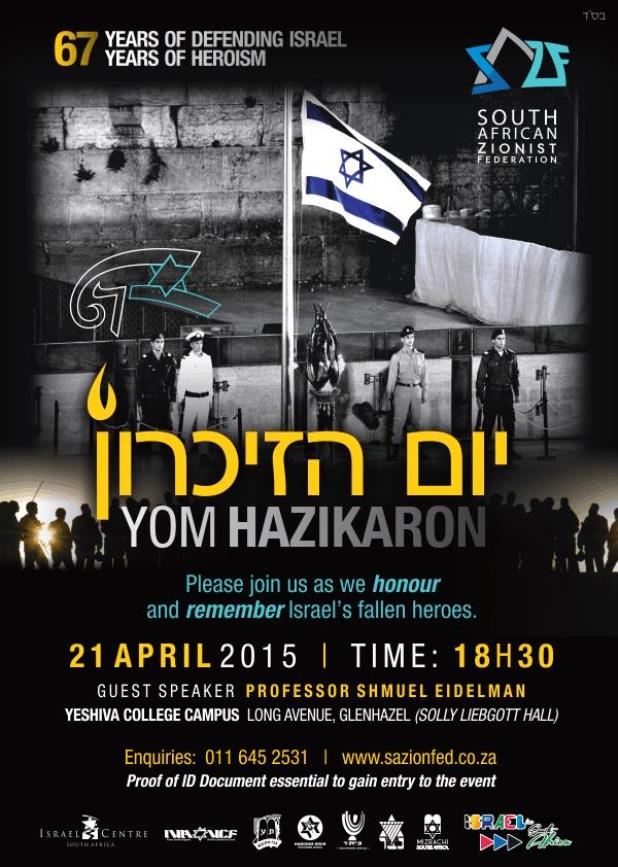
Israel

Remembering those who fell for freedom
ANT KATZ
Why Yom Hazikaron? SEE BELOW
In Johannesburg this year, the ceremony will take place at Yeshiva College on 21 April at 18h30. The sombre event will be addressed by guest speaker Professor Shmuel Eidelman.
 Yom Hazikaron (in full: Yom Hazikaron l’Chalalei Ma’arachot Yisrael ul’Nifgaei Peulot Ha’eivah, in Hebrew: יום הזיכרון לחללי מערכות ישראל ולנפגעי פעולות האיבה; lit. “Day of Remembrance for the Fallen Soldiers of Israel and Victims of Terrorism”) is Israel’s official Memorial Day, enacted into law in 1963.
Yom Hazikaron (in full: Yom Hazikaron l’Chalalei Ma’arachot Yisrael ul’Nifgaei Peulot Ha’eivah, in Hebrew: יום הזיכרון לחללי מערכות ישראל ולנפגעי פעולות האיבה; lit. “Day of Remembrance for the Fallen Soldiers of Israel and Victims of Terrorism”) is Israel’s official Memorial Day, enacted into law in 1963.
See poster of the event below for further details and contact your local SAZF office to get details for event schedules outside Johannesburg
Thousands of SA Jews attend Yom Hazikaron remembrences throughout the country every year.
The History of Yom Hazikaron
In 1949 and 1950, the first two years after the declaration of the State of Israel, memorial services for soldiers who fell in the War of Independence were held on Independence Day (Yom Ha’atzmaut). Services at military cemeteries in Israel were coordinated between the IDF and the Ministry of Defence.
A concern arose, expressed by families of fallen soldiers, to establish a separate Memorial Day observance distinct from the festive celebrations of national independence. In response, and in light of public debate on the issue, Prime Minister David Ben-Gurion – also serving as Minister of Defence at the time – established in January 1951 the “Public Council for Soldiers’ Commemoration.”
This council recommended establishing the 4th of Iyyar, the day preceding Independence Day, as the “General Memorial Day for the Heroes of the War of Independence”.
The proposal was approved by the Knesset in the same year.
A sombre day
Yom Hazikaron is observed for all those who fell since 1860, when Jews were first allowed to live in Palestine outside of Jerusalem’s Old City walls. National memorial services are held in the presence of Israel’s top leadership and military personnel.
The sombre day opens with a siren at sunset. The siren is heard all over the country and lasts for one minute, during which Israelis stop everything (including driving, which stops highways) and stand in silence, commemorating the fallen and showing respect.
The official ceremony to mark the opening of the day takes place at the Kotel (Western Wall) and the flag of Israel is lowered to half-mast.
A two-minute siren is sounded at 11h00 the following morning, which marks the opening of the official memorial ceremonies and private remembrance gatherings at each cemetery where soldiers are buried. Many Israelis visit the resting places of loved ones throughout the day. The day officially draws to a close at sunset – when Yom Ha’atzmaut begins – with the official ceremony of Israel Independence Day at the national military cemetery on Mount Herzl.
At this stage, the flag of Israel is returned to its full-mast position.
One of the government-owned television stations screens the names of all the fallen in chronological order (rank, name, Hebrew date deceased and secular date) over the course of the day. Names appear for about three seconds each.
STORY CONTINUES BELOW POSTER

Related on the website – Read them all
Scheduling and timing
The decision to schedule Yom Hazikaron right before Yom Ha’atzmaut is no coincidence. It was intended to remind people of the price paid for independence and of what was achieved with the soldiers’ sacrifice. This transition shows the importance of this day among Israelis, most of whom have served in the armed forces or have a connection with people who were killed during their military service.
To avoid the possibility of Shabbos desecration, should either of these events take place on Saturday night, both Yom Hazikaron and Yom Ha’atzmaut are observed one or two days earlier. Likewise, should Yom Hazikaron falls on Shabbos, both observances are rescheduled to one day later. The two are always moved in tandem.




